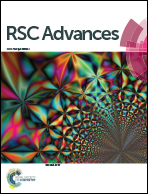Atmospheric chemistry of alkyl iodides: theoretical studies on the mechanisms and kinetics of CH3I/C2H5I + NO3 reactions†
Abstract
The gas-phase reactions of CH3I and C2H5I with NO3 radicals have been studied using a dual-level direct kinetics method. The minimum energy paths have been refined by CCSD(T) and QCISD(T) methods. One displacement and two hydrogen abstraction processes were found for the reaction of CH3I + NO3. For the reaction of C2H5I + NO3, three hydrogen abstraction and one displacement channel were found. The hydrogen abstraction from the –CH2– group was found to be the dominant channel. The displacement channel of the title reactions may be negligible because of the high barrier. The rate constants for the individual reaction channels were followed by means of the canonical variational transition state with the small-curvature tunneling correction. The calculated rate constants were in reasonable agreement with the available data from experiments. The Arrhenius expressions for the title reactions are given as follows: ka = 8.62 × 10−32T6.66 exp(1324.23/T), kb = 9.48 × 10−27T5.75 exp(−655.34/T) cm3 per molecule per s. The atmospheric lifetimes of CH3I and C2H5I determined by reaction with the NO3 radical were about 3.07 and 5.86 h, which indicate that they can be degraded in the gas phase within a short time to serve as a source of reactive iodine compounds at night-time.


 Please wait while we load your content...
Please wait while we load your content...